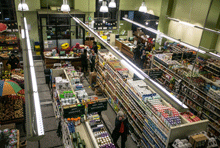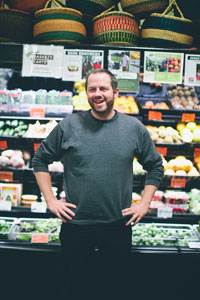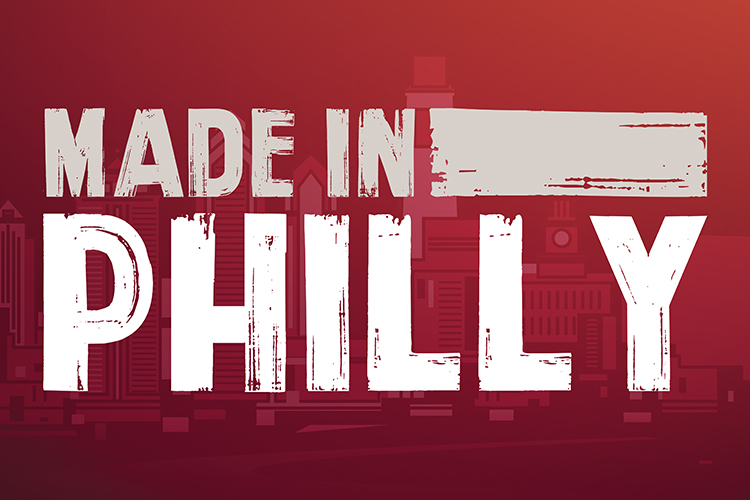 Bull Gervasi, Mariposa’s expansion project manager, at the new co-op location.Food co-ops are hardwired to work with others—other co-ops, other businesses, their neighbors. It’s part of their founding principles, their bylaws and their DNA. When Mariposa Co-op expanded to a nearby location after 40 years in business at 4726 Baltimore Ave., they quintupled in square footage, tripled their staff, doubled their membership and quadrupled their sales. But perhaps the most important expansion was their involvement in the community.
Bull Gervasi, Mariposa’s expansion project manager, at the new co-op location.Food co-ops are hardwired to work with others—other co-ops, other businesses, their neighbors. It’s part of their founding principles, their bylaws and their DNA. When Mariposa Co-op expanded to a nearby location after 40 years in business at 4726 Baltimore Ave., they quintupled in square footage, tripled their staff, doubled their membership and quadrupled their sales. But perhaps the most important expansion was their involvement in the community.
“Our total space was 500 square feet,” says Bull Gervasi, expansion project manager, and now produce department and facilities department coordinator. “We did as much as we could with the space, but … there were limitations to how involved we could be in the neighborhood, and the support we could give to other organizations and businesses.”
Mariposa was also only open to members, a once common restriction among co-ops that is increasingly rare, but made sense given the store’s physical limitations.
By 2007, it had become clear to the staff that a change was necessary. The following year, the membership gave its blessing to search for a new location. “Our membership is very concentrated around the old store, and we wanted to stay within a five-block radius of that store for that reason,” Gervasi says. “We didn’t want to move to an entirely new neighborhood and hope that our members would follow.”
 A year later, the co-op began negotiations to purchase the Beulah Tabernacle Church, one block away at 4824 Baltimore Avenue. “There’s only so many spaces in a five-block radius that are significantly larger than our place and for sale,” Gervasi says. “We looked at four or five other locations seriously … this one was far superior … aesthetically, as well as strategically being placed so close to the old store.”
A year later, the co-op began negotiations to purchase the Beulah Tabernacle Church, one block away at 4824 Baltimore Avenue. “There’s only so many spaces in a five-block radius that are significantly larger than our place and for sale,” Gervasi says. “We looked at four or five other locations seriously … this one was far superior … aesthetically, as well as strategically being placed so close to the old store.”
Before the expansion could proceed, several organizational changes had to be made. “The biggest change was opening our store to the public for shopping rather than only to members,” says Peter Collopy, board secretary. “It made both financial and ethical sense to offer our services to everyone in the neighborhood.” Some members opposed the change, but a referendum passed with more than 90 percent of the vote. Another change was the creation in 2009 of a board of delegates (previously all major decisions were made by the entire membership).
Mariposa secured the new building in September 2010, and as the architects and contractors started planning the expansion, the staff was hard at work figuring out how to raise $2.5 million to pay for it.
The Philadelphia Industrial Development Corporation (PIDC), the Reinvestment Fund, and the Pennsylvania Department of Community Economic Development were major funding sources, but the biggest single component—30 percent—came from grassroots fundraising. When renovation began in September 2011, the co-op was still closing in on its fundraising goal.
“The moment that I realized we had no choice but to succeed was when construction started,” says Leah Pillsbury, who coordinated the capital campaign. “They were downstairs spending money and I was upstairs trying to raise it. My job was to keep up.”
But the fundraising campaign was a pivotal point in Mariposa’s blossoming interaction with the surrounding community.
“There’s a baker that we work with who ended up giving us a loan toward the expansion, in the process before we actually opened up,” Gervasi says. “There have been many local businesses that have donated gift certificates and products for raffles and silent auctions and things like that, going through the expansion process. Different businesses in the neighborhood hosted events as fundraisers for us. So, yeah, there’s been a lot of help and community building along the way there.”
But it wasn’t just the neighborhood community that pitched in.
 Peter Frank“The co-op to co-op generosity was really amazing during expansion,” says Peter Frank, Mariposa’s organizational facilitator. “That conversation is continuing to grow and expand … with Weavers Way and Swarthmore and even Newark Natural Foods in Delaware. Thinking about how can we collaborate together, share services. During expansion, there were a lot of co-ops that lent Mariposa money, which was really amazing, and co-ops that aren’t even local, not even in the state of Pennsylvania, contributing large amounts of money … that was pretty amazing.”
Peter Frank“The co-op to co-op generosity was really amazing during expansion,” says Peter Frank, Mariposa’s organizational facilitator. “That conversation is continuing to grow and expand … with Weavers Way and Swarthmore and even Newark Natural Foods in Delaware. Thinking about how can we collaborate together, share services. During expansion, there were a lot of co-ops that lent Mariposa money, which was really amazing, and co-ops that aren’t even local, not even in the state of Pennsylvania, contributing large amounts of money … that was pretty amazing.”
Gervasi agrees. “And even beyond the financial aspect, especially Weavers Way went above and beyond, offering consulting help, offering their member labor to set up the shelves when we were getting ready to open up, looking over our plans for the store,” he says. “Almost every aspect of the store, they offered help with, which was extremely valuable, having just gone through their renovation in Chestnut Hill … to have that help was amazing, and made it a hell of a lot easier.”
Mariposa’s new store opened in June 2012. The design has won awards, sales are way ahead of projections, membership has increased by 62 percent, and payroll has grown from nine mostly part-timers to a staff of 46, with 35 full-time.
The expansion also allowed Mariposa to expand its product lines. “We’re trying to squeeze in as broad a variety of products [and] price levels … as we can, for as broad a selection of folks [as possible] so we can be their one-stop shop, keeping their money in the neighborhood,” Gervasi says.
And more of those new products are local. “Bringing in fresh and frozen meat, the vast majority of that is locally sourced. The vast majority of our dairy and eggs is locally sourced. In season, most of our produce is locally sourced,” he says. “It probably averages out to be about 40 percent of our produce ends up being locally sourced. In the summer, it’s a much higher percentage.”
Removing the membership requirement has made those products available to more local people. “We have a lot more sales from non-members and people who were not exposed to our product are now being exposed to it,” Frank says. “Some of those folks are now joining, slowly. But way more folks are getting fresh and healthy produce and products from us.”
Other businesses in the area have also noticed an increase in business. “There’s been quite an uptick in activity on the whole block since the expansion,” says Vince Whittacre, co-owner of the Gold Standard Café. “Now that they are open to non-members, they have opened up to a lot of the neighbors. We were able to join as a business, which is great. Now we can get last minute things and fresh produce, so that helps a great deal. They have also joined the business association, so they are really helping to promote the whole avenue.”
A year and a half after the expansion, the relationships with neighbors, businesses and organizations that helped make it happen are stronger, broader and more robust.
Just as Mariposa received support and expertise from co-ops like Weavers Way and Swarthmore, they are sharing the lessons they learned with startups like Kensington Community Food Co-op and South Philly Food Co-op. “Mariposa studied the Weavers Way Chestnut Hill expansion to see how you line up financing, how you line up the fundraising drive, how does actual construction work,” Frank says. “And now we’re kind of able to give really amazing advice to some of the startups.”
 Mariposa has become an active part of the regional co-op scene in more structured ways, as well. In 2012, Mariposa and Weavers Way helped establish the Philadelphia Area Cooperative Alliance (PACA), which seeks to help all sorts of co-ops—including credit unions, worker cooperatives, consumer co-ops and housing co-ops—to work together to grow the cooperative economy. Mariposa is also active in the Mid-Atlantic Food Co-op Alliance (MAFCA), a group formed in 2010 to help promote food co-ops. In 2012, Mariposa hosted a quarterly meeting of the MAFCA, which includes 21 co-ops in six states.
Mariposa has become an active part of the regional co-op scene in more structured ways, as well. In 2012, Mariposa and Weavers Way helped establish the Philadelphia Area Cooperative Alliance (PACA), which seeks to help all sorts of co-ops—including credit unions, worker cooperatives, consumer co-ops and housing co-ops—to work together to grow the cooperative economy. Mariposa is also active in the Mid-Atlantic Food Co-op Alliance (MAFCA), a group formed in 2010 to help promote food co-ops. In 2012, Mariposa hosted a quarterly meeting of the MAFCA, which includes 21 co-ops in six states.
Mariposa’s connections to the local community continues to strengthen as well. “There’s lots of small nonprofit organizations that look to us as this sort of big brother institution,” Frank says. “We’re able to partner with a lot of them and help them with their smaller projects, whether it’s selling Mill Creek Farm’s produce or the West Philly Tool Library, having some of our member labor go work for them.”
Mariposa directly supports or partners with dozens of local groups, including Cedar Park, Eastern Conference for Workplace Democracy, Urban Nutrition Initiative and the Philadelphia Student Union.
“It’s part of being a good neighbor,” Gervasi says. “We want to support the neighborhood. I feel like that’s very different than the traditional business model, where maybe a corporate chain store doesn’t necessarily have as much investment in the neighborhood that they’re in. Whereas we—most of us live in the neighborhood, we work in the neighborhood, our neighbors come through the doors and we want to support them. We want to be good neighbors. … Our mission kind of states that: We are trying to supply the residents of West Philly and beyond with locally sourced, healthy foods.”
Plans are already in the works for more improvements: a new, more efficient heating and cooling system, an expanded deli and prepared foods department, and expanding offerings in the co-op’s new community room, which already hosts workshops, cooking classes, film screenings and a very popular Scrabble night.
But while the expansion was officially completed a year and a half ago, much work still remains. “We’re still very much in expansion mode,” Gervasi says. “We’re still going through a lot of growing pains, figuring out what policies make sense, and adjusting that and settling into that space… figuring out how to work most effectively and be as good a part of the community of co-ops and the West Philly community as we can be.”
Story by Jon McGoran and photos by Neal Santos.
This story originally appeared in Beyond Big Business, a special insert brought to you by The Merchant’s Fund and Grid, found in Issue #58.









The Amazing Spider-Man 2 Leather Jacket:
Amazing writing! I have come across several blogs and topics but this one hold me well and made me to read till end. The way you write is good and I’m impressed with it. However, the jacket of Spiderman is also good on Fjacket’s that’s made in original pattern of his costume. The jacket is made in blue and red web pattern on the exterior of the outfit to give it the best look. The fans will also love the Spider logo on the chest that gives the complete identification of Spiderman. It’s comfortable to wear because of front zip closing and the synthetic leather. The film is good and the second edition of Peter Parker life is better than the first one. Soon he will be back with Avengers as Sony and Marvel deals for it. The price is reasonable at Fjackets and they always provide the best for their customers.